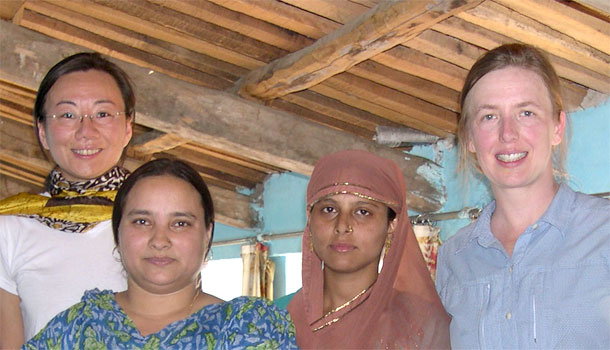
Building the bridge of engineers and environmentalists
Thursday 11 August 2011
A global network, Engineers for a Sustainable World, is now headquartered at UC Merced. Students work on innovative projects from supplying solar-generated electricity to villages in India to replacing polluting diesel fuel on international cargo ships.
In his seminal 1971 book “Encounters with the Archdruid,” writer John McPhee cast engineers and environmentalists as natural enemies.
He pitted legendary Sierra Club executive director David Brower against his ideological foes: a mining geologist who traveled the globe in search of minerals to exploit and Floyd Dominy, the head of the U.S. Army Corps of Engineers during its heyday of rerouting rivers and turning canyons to concrete.
Environmentalists and engineers were like cats and mice, the Yankees and the Red Sox. It seemed the war would never end — until just recently.
Back in the 1970s, Dan Hirleman was a kid from Kansas starting college. Today, he is dean of engineering at UC Merced and director of a global network, Engineers for a Sustainable World (ESW).
In July, ESW's headquarters moved to UC Merced, where students from the group’s local chapter are working on innovative projects ranging from supplying solar-generated electricity to villages in India to replacing polluting diesel fuel on international cargo ships. (See sidebar. Graduate student Brandi McKuin, far right, is in above photo from India).
ESW was founded in 2001 by Regina Clewlow, a student at Cornell University. Today, the organization has grown to 4,000 students, faculty and professionals at 24 chapters, including one in Rwanda.
UC Merced students rave about ESW and Hirleman’s commitment to sustainability education and research. By his own account, Hirleman was a late bloomer when it came to putting the environment front and center. Nevertheless, his Ph.D. research into the use of methanol for engines was ahead of its time, dovetailing with environmentalists’ calls for reducing oil consumption. In the 1970s, he had to go all the way to Denmark to find a laboratory where he could test his ideas.
During his undergraduate years, Hirleman interned with the Boeing Co. In those days, the U.S. led the world in aerospace. Thirty years later, Hirleman noted, most of the parts of a Boeing 787 are made outside the U.S.
“For most of my years in engineering education I was all about national competitiveness,” Hirleman said. “It was clear that there was no such thing as regional engineering anymore, so I was focused on training students to work in a global market.”
At Purdue University, he earned his undergraduate and graduate degrees and returned to teach from 1999-2010, including heading the mechanical engineering department. There, Hirleman started a program for engineers to study and work abroad, and they worked on projects with their counterparts from other countries. His international outreach made him the first engineer to win CRDF Global's prestigious George E. Brown, Jr. Award for International Scientific Cooperation in 2008.
At the awards ceremony in Washington, D.C., someone approached Hirleman after his acceptance speech and told him that he needed to re-engineer his thinking. “He said, ‘Idiot, you’re missing an entire market!” Hirleman said wryly. “It’s not about competitiveness. It’s about collaboration.”
It was a Eureka moment. Another came after he met Regina Clewlow and they collaborated on an ESW project to help farmers in Rwanda dry their crops. Excited about the potential opportunities, he held an organizational meeting to find out if students wanted to start an ESW chapter at Purdue.
“The attendance was outstanding, even without free pizza, as I recall,” Hirleman said. “I had been thinking about the international aspect of our work, but the students were responding to the concept of sustainability.”
Hirleman remembered solar technology from the Jimmy Carter administration in the 1970s. But it wasn’t until the 1990s, when people started talking about developing technologies with no waste, “closing the loop,” that the idea of sustainability caught fire with him.
“That’s a way to talk about a concept that an engineer can understand,” he said.
“There’s always been that underlying focus of engineering: how to be more efficient. There was a point where I thought, ‘Gee, as much as I love the standard of living that fossil fuels bring us, in the long run we can surely do better than digging up dead algae and fossils.’ There are more elegant ways to deal with the energy we want to use.”
According to Hirleman, the greatest challenge for engineers in the 21st century is reducing the environmental impacts of rapid growth in the developing world. He believes the current generation of students has an advantage because they instinctively think about engineering problems in terms of sustainability.
“If students from the U.S. and countries like China and India can collaborate on real sustainable development projects with shared goals, then we'll have an impact,” Hirleman said.
That also is the goal of globalHub.org, an engineering cyber-community that Hirleman founded with colleagues and National Science Foundation support in 2008. "It's engineering diplomacy, and then some."
He paused to take a breath, and perhaps to think about the magnitude of the task. At 59, Hirleman’s career has followed the trajectory of globalization. As a younger man, Hirleman’s focus was on American competitiveness. While competing globally wasn’t easy, it was, arguably, simpler than solving global environmental problems. But for professionals in virtually every field, work is more complicated than anyone realized back in 1971.
In biology, for instance, phrases like “natural” enemies are no longer in vogue. Biologists say that this catchall phrase was a simplification of far more complex relationships.
As it turns out, the relationship between engineers and the natural world isn’t quite so simple, either.
“It’s all about reframing the question,” Hirleman said. “Then you get creativity firing on other levels.”